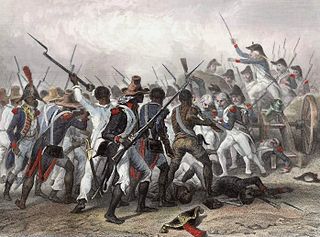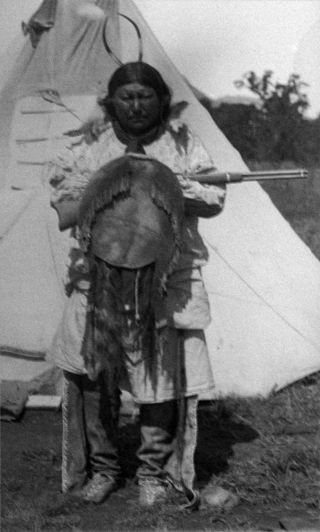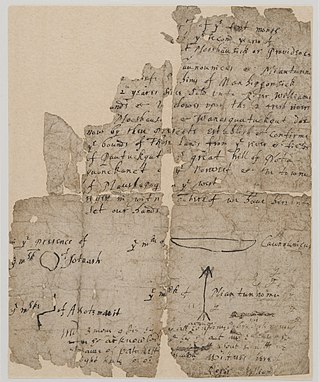
Tribal sovereignty in the United States is the concept of the inherent authority of Indigenous tribes to govern themselves within the borders of the United States.
Edward Riley Bradley was an American steel mill laborer, gold miner, businessman and philanthropist. As well as a race track proprietor, he was the preeminent owner and breeder of Thoroughbred racehorses in the Southern United States during the first three decades of the 20th century. Testifying before a United States Senate committee in April 1934, Bradley identified himself as a "speculator, raiser of race horses and gambler". He appeared on the cover of Time magazine on May 7, 1934. In the year 2000, the Florida Department of State honored him as one of their Great Floridians.
The Battle of Plum Creek was a clash between allied Tonkawa, militia, and Rangers of the Republic of Texas and a huge Comanche war party under Chief Buffalo Hump, which took place near Lockhart, Texas, on August 12, 1840, following the Great Raid of 1840 as the Comanche war party returned to west Texas.
The Texas–Indian wars were a series of conflicts between settlers in Texas and the Southern Plains Indians during the 19th-century. Conflict between the Plains Indians and the Spanish began before other European and Anglo-American settlers were encouraged—first by Spain and then by the newly Independent Mexican government—to colonize Texas in order to provide a protective-settlement buffer in Texas between the Plains Indians and the rest of Mexico. As a consequence, conflict between Anglo-American settlers and Plains Indians occurred during the Texas colonial period as part of Mexico. The conflicts continued after Texas secured its independence from Mexico in 1836 and did not end until 30 years after Texas became a state of the United States, when in 1875 the last free band of Plains Indians, the Comanches led by Quahadi warrior Quanah Parker, surrendered and moved to the Fort Sill reservation in Oklahoma.
The Treaty of Bird's Fort, or Bird's Fort Treaty was a peace treaty between the Republic of Texas and some of the Indian tribes of Texas and Oklahoma, signed on September 29, 1843. The treaty was intended to end years of hostilities and warfare between the Native Americans and the white settlers in Texas. The full title of the treaty was "Republic of Texas Treaty with the Indigenous Nations of the Delaware, Chickasaw, Waco, Tawakani, Keechi, Caddo, Anadahkah, Ionie, Biloxi, and Cherokee." The principal negotiators for the Republic of Texas were Edward H. Tarrant and George W. Terrell.

The 1842 Slave Revolt in the Cherokee Nation was the largest escape of a group of slaves to occur in the Cherokee Nation, in what was then Indian Territory. The slave revolt started on November 15, 1842, when a group of 20 African-Americans enslaved by the Cherokee escaped and tried to reach Mexico, where slavery had been abolished in 1829. Along their way south, they were joined by 15 slaves escaping from the Creek Nation in Indian Territory.

White Horse was a chief of the Kiowa. White Horse attended the council between southern plains tribes and the United States at Medicine Lodge in southern Kansas which resulted in the Medicine Lodge Treaty. Despite his attendance at the treaty signing he conducted frequent raids upon other tribes and white settlers. Follower of such elders as Guipago, Satanta and old Satank, he was often associated with Big Tree.

The United States was the first jurisdiction to acknowledge the common law doctrine of aboriginal title. Native American tribes and nations establish aboriginal title by actual, continuous, and exclusive use and occupancy for a "long time." Individuals may also establish aboriginal title, if their ancestors held title as individuals. Unlike other jurisdictions, the content of aboriginal title is not limited to historical or traditional land uses. Aboriginal title may not be alienated, except to the federal government or with the approval of Congress. Aboriginal title is distinct from the lands Native Americans own in fee simple and occupy under federal trust.

The Comanche–Mexico Wars was the Mexican theater of the Comanche Wars, a series of conflicts from 1821 to 1870. The Comanche and their Kiowa and Kiowa Apache allies carried out large-scale raids hundreds of miles deep into Mexico. The raids were stimulated by the desire of Comanches to accumulate wealth through plunder, principally horses, mules, and Mexican captives for ransom or slaves who became integrated into the tribe. The raids escalated proportionally to Mexico's inability to defend its citizens during the turbulent years after it gained independence in 1821 and a large and growing market in the United States for stolen Mexican horses and cattle.
County of Oneida v. Oneida Indian Nation of New York State, 470 U.S. 226 (1985), was a landmark United States Supreme Court case concerning aboriginal title in the United States. The case, sometimes referred to as Oneida II, was "the first Indian land claim case won on the basis of the Nonintercourse Act."

The Marshall Court (1801–1835) issued some of the earliest and most influential opinions by the Supreme Court of the United States on the status of aboriginal title in the United States, several of them written by Chief Justice John Marshall himself. However, without exception, the remarks of the Court on aboriginal title during this period are dicta. Only one indigenous litigant ever appeared before the Marshall Court, and there, Marshall dismissed the case for lack of original jurisdiction.

The Fort Martin Scott Treaty of 1850 was an unratified treaty between the United States government and the Comanche, Caddo, Quapaw, Tawakoni, Lipan Apache, and Waco tribes in Texas. The treaty was signed in San Saba County, Texas, but named after the nearest military outpost, Fort Martin Scott in Gillespie County, on the outskirts of Fredericksburg.
South Carolina v. Catawba Indian Tribe, Inc., 476 U.S. 498 (1986), is an important U.S. Supreme Court precedent for aboriginal title in the United States decided in the wake of County of Oneida v. Oneida Indian Nation of New York State (1985). Distinguishing Oneida II, the Court held that federal policy did not preclude the application of a state statute of limitations to the land claim of a tribe that had been terminated, such as the Catawba tribe.

Mashpee Tribe v. New Seabury Corp., 592 F.2d 575, was the first litigation of the Nonintercourse Act to go to a jury. After a 40-day trial, the jury decided that the Mashpee Tribe was not a "tribe" at several of the relevant dates for the litigation, and the United States Court of Appeals for the First Circuit upheld that determination.

The Supreme Court of the United States, under Chief Justice Roger B. Taney (1836–1864), issued several important decisions on the status of aboriginal title in the United States, building on the opinions of aboriginal title in the Marshall Court.

An Organic Act is a generic name for a statute used by the United States Congress to describe a territory, in anticipation of being admitted to the Union as a state. Because of Oklahoma's unique history an explanation of the Oklahoma Organic Act needs a historic perspective. In general, the Oklahoma Organic Act may be viewed as one of a series of legislative acts, from the time of Reconstruction, enacted by Congress in preparation for the creation of a united State of Oklahoma. The Organic Act created Oklahoma Territory, and Indian Territory that were Organized incorporated territories of the United States out of the old "unorganized" Indian Territory. The Oklahoma Organic Act was one of several acts whose intent was the assimilation of the tribes in Oklahoma and Indian Territories through the elimination of tribes' communal ownership of property.

Republic of Texas v. Inglish, Dallam 608 (1844), was a case decided by the Supreme Court of the Republic of Texas which held that to be a valid claim for land, the land claim must have been authorized by the constitution after March 2, 1836; or by authority under Mexican law prior to that date.

The Supreme Court of the Republic of Texas was the court of last resort for legal matters in the Republic of Texas from the Republic's independence from Mexico in 1836 until its annexation by the United States of America in 1846. The current Supreme Court of Texas was established that year.
United States v. Cook, 86 U.S. 591 (1873), was a United States Supreme Court case in which the Court held that Indian tribes do not own the land their reservations are on, the land is owned by the United States and the Indians only have a right to occupy the land. They may not cut and sell timber merely for the purpose of selling timber, they may only sell timber that was cut incidental to another purpose. The government has a right to take action to recover damages for timber sold illegally from that land.











